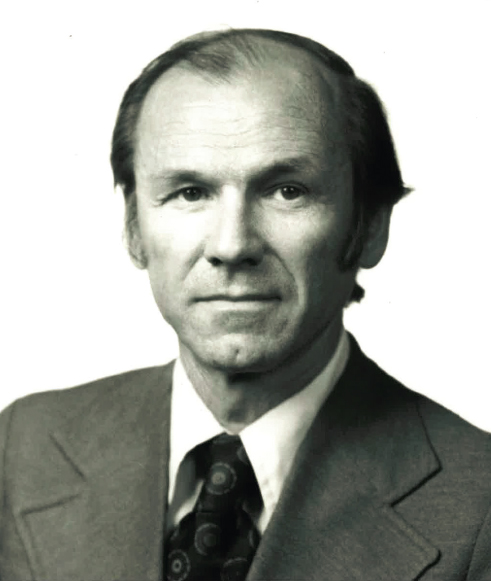
ANATOL ROSHKO
1923–2017
Elected in 1978
“Contributions to our knowledge of separated flows, turbulent wakes, and mixing layers.”
BY MORTEZA GHARIB AND ROBERT PERKINS
ANATOL ROSHKO, the Theodore von Kármán Professor Emeritus at the California Institute of Technology, died January 23, 2017, at the age of 93 at his home in Altadena. He is recognized for his research on fluid and gas dynamics, in particular his identification, through high-speed photography, of discrete structures in turbulence.
Roshko was born July 15, 1923, in Bellevue, Alberta, Canada. He received a BSc degree in engineering physics from the University of Alberta in 1945 and, after a brief tour in the Royal Canadian Artillery, came to the Guggenheim Aeronautical Laboratories at Caltech (GALCIT, now known as the Graduate Aerospace Laboratories at Caltech). He earned his MS (1947) and PhD (1952) degrees in aeronautics and spent the rest of his professional career at Caltech, starting as a research fellow (1952–54) and senior research fellow (1954–55). He went on to be appointed assistant professor (1955–58), associate professor (1958–62), and professor (1962–85). He was named von Kármán Professor in 1985, served as acting director of GALCIT (1985–87), and retired in 1994.
An accomplished theorist, modeler, and experimentalist, Roshko made seminal contributions to problems of bluff-body aerodynamics, separated flow, shock-wave boundary-layer interactions, shock-tube technology, and the structure
of turbulent shear flows. With his advisor, pioneering aerodynamics researcher Hans Liepmann, he coauthored the classic textbook Elements of Gasdynamics, published in 1957 by Wiley and translated into Russian, Spanish, and Japanese, a worldwide resource used by generations of graduate students.
At the time of his passing, Roshko had been teaching a course at Caltech with his former student and long-time collaborator and friend, Garry Brown of Princeton University. Their first paper together, “On density effects and large structure in turbulent mixing layers,” was published in 1974 in the Journal of Fluid Mechanics and became the most widely cited paper in the journal’s history. It announced the finding of large coherent structures in turbulence. Before this work, turbulence was considered a featureless subject, totally random and unrecognizable. Roshko and Brown showed that not to be the case. Indeed, through high-speed photography, they showed that turbulence has internal organization in the form of large coherent vortical structures, a discovery that proved crucial to a more accurate understanding of aerodynamics.
Roshko was also a consultant to government laboratories and companies including McDonnell-Douglas, Rockwell International, and General Motors. He helped organize the Wind Engineering Research Council and served on its executive board (1970–83).
In addition to his election to the National Academy of Engineering (1978), Roshko was a member of the National Academy of Sciences (2002), a fellow of the American Academy of Arts and Sciences, American Institute of Aeronautics and Astronautics (AIAA), American Physical Society (APS), and Canadian Aeronautics and Space Institute, and an honorary member of the Indian Academy of Sciences. His many honors include the APS Otto Laporte Award (1987), a Distinguished Alumni Award from the University of Alberta (1998), AIAA’s Fluid Dynamics Award (1998) and Reed Aeronautics Award (2009), and the Timoshenko Medal (1999) of the American Society of Mechanical Engineers.
Notwithstanding his high-profile success and recognition, Roshko was always approachable and good-natured. He had
a talent for gently encouraging students to solve problems creatively. His graduate students remember him as a generous teacher who challenged them to be innovative and resourceful.
International students, colleagues, and visiting researchers found hospitality and conviviality at the home of Anatol Roshko and his wife, Aydeth, an accomplished artist, who passed away about a decade ago. She was a second mother to Caltech grad students and their friends who visited the couple’s home. Colleagues and students have fond memories of parties around the fireplace at Roshko’s house and hikes with him in the San Gabriel Mountains above Altadena.
In letters from students, scientists, and colleagues from industry, written for Anatol on the occasion of a symposium to honor him on his 75th birthday, it’s clear that he made an impact on each with his warmth, willingness to listen, high standards and sense of fairness, tough questions, and readiness to admit when he didn’t know the answers. Several letter writers appreciated that he knew how to ask limited questions so that answers could be found and new understanding achieved. One correspondent mentioned that on several occasions Roshko pointed out that “there are many simple experiments which have been carried out for as long as 100 years and we still haven’t gotten them right, for example, the vortex shedding problem.” In another remembrance, Gary Ratekin and the aerodynamics staff at Rocketdyne mentioned that, thanks to Roshko’s guidance in understanding the flow in the space shuttle main engine, they created a new duct design for future flights.
Alan Davenport wrote, “It might be said that, for a person of Anatol’s trim physique, the wake he leaves behind is much wider than bluff-body theories would predict. His figurative, intellectual wake has washed up on students, researchers, wind engineers, aerodynamicists, and beyond. His quiet-spoken but reverberant statements on fluid mechanics have provided inspiring insights to many.”
Anatol is survived by his sons Peter and Richard, daughter Tamara, 12 grandchildren, and 13 great-grandchildren.




